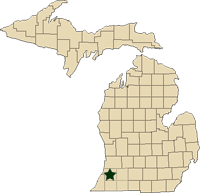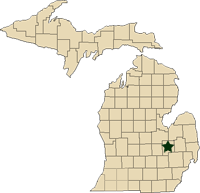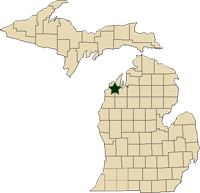Regional reports on Michigan fruit – April 17, 2012
MSU Extension educators’ pest and fruit updates for Michigan.
This week’s regional reports:
- Southwest Michigan - Mark Longstroth, Bill Shane, Diane Brown
- Southeast Michigan - Bob Tritten
- Northwest Michigan - Nikki Rothwell, Duke Elsner, Erin Lizotte
Southwest Michigan – Mark Longstroth, Bill Shane, Diane Brown, Michigan State University Extension
|
Weather
Last week was cool. Highs were in the 50s and lows around freezing. Wednesday (April 11) was cold and windy with clearing and calm conditions in the evening. Temperatures dropped quickly after sundown and lows in many areas were in the mid- to low 20s. The freeze Thursday morning was a radiation freeze (see Enviro-weather’s report). It had wide spread frost, indicating the low was at or below the dew point. The temperature inversion was weak, so wind machines were not as effective. Damage was wide spread and severe in flat areas and lower fruit sites where cold air collected under calm conditions. Fruit sites with good air drainage were less affected.
The weekend was warmer with rain and highs near 70. Soils are wet. Weather for this week is forecast to be cool and wet. There is a chance of another freeze this weekend. Our growing degree day accumulations continue to run about a month ahead of normal.
Southwest Michigan Growing Degree Day Totals from January 1 through April 15 | |||
|
Location |
GDD 42 |
GDD 45 |
GDD 50 |
|
517 |
426 |
294 | |
|
461 |
376 |
254 | |
Tree fruit
Sunday’s (April 15) rain was a marginal infection for apple scab and cherry leaf spot. Some sites had infections, others did not. Treatment for San Jose scale crawlers is about 10 to 14 off, depending on when we start trapping males. The cool weather forecast will inhibit plum curculio activity and egglaying.
Apricots are 12 to 18 mm in diameter.
Peaches are in the shuck or at shuck split. There is still a good amount of fruit, especially in good peach sites. Oriental fruit moth catches increased markedly over the past week in spite of the cold weather. We think a new biofix is justified based on this jump in trap catch. Tarnished plant bugs adults are present in orchards and are a concern when fruit starts emerging from the shuck. Growers using low rates of copper to inhibit bacterial spot should consider shifting to other materials such as mycoshield or Syllit plus captan to avoid copper injury to peach foliage.
Sweet cherries are at shuck split or out of the shuck. There is a wide range in fruit size from 6 to 12 mm in diameter. Protectants for cherry leaf spot are needed. Cherry leaf spot infects the leaves through the stomates, so the disease can only infect expanded mature leaves which have functional stomates.
Tart cherry bloom is ending and some fruit have emerged from the shuck. These rare fruits are 4 to 6 mm. There is a wide range in fruit size, and some sites have a broader range of sizes. It will be several weeks before fruit set is determined. There are still plenty of small green cherries in the shucks. Trees are leafed out and controls for cherry leaf spot need to be applied.
In plums, Japanese plums are emerging from the shuck. The largest fruit are 4 to 6 mm. European plums are still in the shuck. Black knot requires wet conditions for infection and growers should be maintaining controls. Tarnished plant bug and plum curculios will be concerns when warm weather returns.
Apple bloom is ending. Damage from recent freezes is severe at some sites. Most orchards show some damage, but estimating the crop and the need to thin will have to wait until fruit growth can be assessed. In some sites, varieties such as Red and Golden Delicious had low flower numbers to begin with, and the freeze damage compounds the situation.
Bloom has been too cool for fire blight. Apple scab symptoms should be showing up now in unsprayed orchards, so growers should begin to check their orchards. Growers should use the scab infection tool on Enviro-weather to track scab. Scab ascospore numbers have been very high in some sites. Powdery mildew symptoms, both primary infections from last year and secondary spread, are easy to see on crabapples. Cool conditions, infrequent rains, and high humidity favor this disease. Traps for codling moth should be out and pheromone disruption should be put out soon for growers using this control approach.
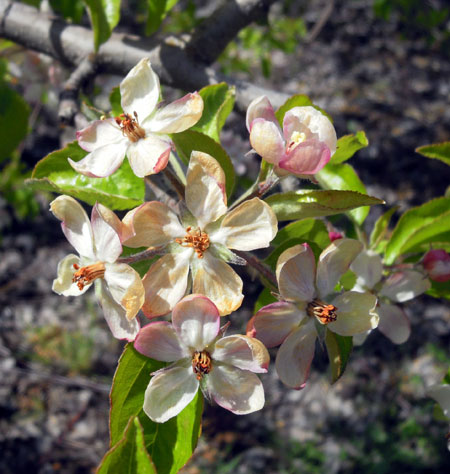
22°F killed these Jonathan apple blossoms.
Pear bloom has ended. It looks as though there will be a heavy drop in pears. Growers will need to protect against pear scab and watch for fire blight conditions.
Small fruit
Juice grapes were damaged severely by Thursday’s freeze (see Enviro-weather’s report). The freeze caused widespread damage. Sites with good air drainage suffered less damage. Lower sites and sites with poor air drainage suffered severely. There was a heavy frost which probably reduced the shoots ability to withstand freezing temperatures. The new shoots in many juice grape plantings were frozen. It will be a month before new growth develops sufficiently for remaining crop potential to be assessed.
Based upon the extent of the damage that occurred, and whether growers anticipate a reduced crop or no crop this year, growers can take steps to minimize the costs of pest management inputs. If a reduced crop is expected, the quality and yield of the remaining fruit will need to be protected. See today’s articles on managing insects and diseases in frost damaged vineyards at the grapes.msu.edu website. Even if no crop is anticipated, there is still a need to provide a minimum disease control program. Vine health and size need to be maintained to allow for the development of next year’s fruit buds. A good weed control program will be important to reduce competition for water and nutrients, especially if no fertilizer will be applied.
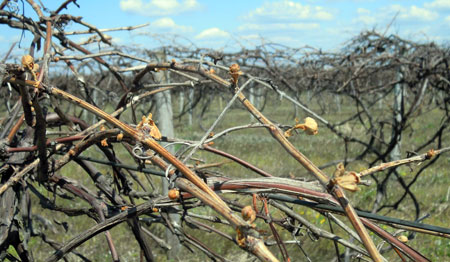
Concord grape shoots and buds killed by the April 12 freeze.
Wine grapes were not as advanced in development and generally are grown in better sites, so they suffered much less injury. With recent rains and warming temperatures, any exposed flower buds will need protection against phomopsis. Grape berry moth is being caught in traps, but we have not reached biofix.
Blueberry bloom is underway. Many blueberry growers with overhead irrigation systems frost protected last Thursday (see Enviro-weather’s report). The Enviro-weather summary for that morning shows high temperatures (near freezing) in Grand Junction, Mich., and South Haven, Mich., indicating that growers were making ice in those fields. Other growers in the area reported temperatures in the mid-20s. Bluecrop flowers opened over the weekend and they are at about 25 percent bloom. Jersey and later blooming varieties are at late pink bud and may open when warmer weather returns. Growers should be prepared to use their overhead irrigation systems for frost control in fields with open blossoms.
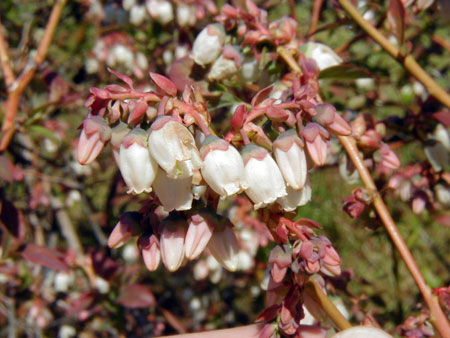
Bluecrop blueberry bloom near South Haven, Mich., on April 16.
There was little additional damage from Thursday’s freeze. Most of the freeze damage so far has occurred to early blooming varieties that were susceptible to the freeze on April 6 (see Enviro-weather’s report) and April 7 (see Enviro-weather’s report). There was a heavy frost on April 7 and most of the damage showed up after that freeze.
The wet, rainy weather forecast for this week is good for spring twig blight diseases such as anthracnose and phomopsis. When good pollinating weather returns, growers should treat for the fruit phase of mummy berry. Cranberry fruitworm traps should be out before bloom.
Strawberry flower trusses are emerging from the crown in many matted row plantings. In strawberry plantings without sprinklers for freeze protection, many flowers have black centers, indicating freeze injury.
In brambles, new leaves are unfolding. Flower clusters are visible in some early summer varieties. Many plants show scorching on the leaves from Thursday’s freeze.
Cranberry beds have been protected from the recent freezes and some are showing areas of green.
Upcoming meetings
Our next Monday fruit meetings will be April 23 at Fruit Acres Farms at 5 p.m..
Don’t forget to register for the first in-season grape meeting, scheduled on April 25 at Southwest Michigan Research and Extension Center from 3 to 8 p.m. This meeting will feature sprayer calibration, rate controllers, and sprayer setup for early season canopies. There will also be discussion about adjusting insect and disease management programs for vineyards that have been frost damaged. Registration is $25, including supper.
Register for the meeting by returning the registration form with $25 per person or contacting the Berrien County Extension office at 269-944-4126. Although on-site registration will be available, registration in advance of the meeting allows for meal planning.
Southeast Michigan – Bob Tritten, Michigan State University Extension
|
Weather
We have experienced one more freeze event across east Michigan in the past week, which was on the morning of Thursday, April 12. This event was a radiation freeze, with colder temperatures aloft. This was the seventh to ninth below 30° freeze/frost event since March 26 for most fruit farms. The extent of damage to flower buds from all of these freeze events is becoming more apparent, and in a few words I would say that damage is “significant and specific to the site.” Apples, sweet cherries and plums are most affected. Peaches and tart cherries have been damaged much less, but as of last Wednesday (April 11) just began to see damage particularly in the southern part of our region. Blueberries appear to have no damage.
We also experienced strong winds yesterday, April16, with gusts over 50 miles per hour. With several of our fruit crops in bloom, I am concerned about the viability of flowers as a result of this wind event.
Our early warm season is running almost three weeks ahead of normal in terms of growth stages, and even more than that in terms of degree day totals. I do not see much spread in growth stages from south to north, as I do in most years. We are generally vulnerable to frost and freeze events for the next three to four weeks.
Rain over the weekend was welcomed by most fruit growers, as our soils were beginning to become dry. Thunderstorms also helped to “green up” our fruit crops. Planting of both trees and small fruits are well along this season.
East Michigan Growing Degree Day Totals for March 1 to April 16 | |||
|
Location |
GDD42 |
GDD45 |
GDD50 |
|
Commerce (Oakland) |
412 |
331 |
218 |
|
Emmett (St Clair) |
392 |
315 |
208 |
|
Flint (Genesee) |
448 |
365 |
248 |
|
Lapeer (Lapeer) |
443 |
363 |
247 |
|
Petersburg (Monroe) |
458 |
370 |
246 |
|
Pigeon (Huron) |
371 |
296 |
196 |
|
Romeo (Macomb) |
400 |
321 |
207 |
Tree fruits
Apple growth took off again late last week and over the weekend, with most apples being nearly at full bloom at full bloom. I am concerned that we have not had great weather for pollination of apples, although bumble bees where flying in yesterday’s (April 16) wind storm.
The full extent of the freeze injury is still playing itself out from our most recent event, but it appears that we have lost over half of our king and side bloom. However, the percent of damage to king and side bloom varies greatly from site to site. At some farms I cannot find a viable king bloom and at others I am finding 25 percent of kings and 80 percent of side bloom damaged. So, at this writing there is an apple crop in the region, but growers are anxious about the viability of the remaining flower buds.
Insect pressure resumed this past week. Oriental fruit moth trap catch is on the raise. Spotted tentiform leafminer adults continue to be caught in traps in the 200 to 300 range. Redbanded leafroller trap catches are on the decline. I have seen no European red mite egg hatch. We are catching the normal number of apple scab spores for this time of the season at both of our monitoring stations. Most growers have had two to three apple scab wetting periods with no infections in the last week. Growers are now adding fire blight to their radar screen as bloom is underway.
I have been concerned about how yellow and sickly the leaves have looked on apples this season. With warm temperatures of late I am starting to see leaves looking a bit better. Many growers have applied foliar nutrients over the last week.
Pears are at petal fall to fruit set. The freeze damage is now becoming more apparent, with a good number of freeze damaged buds being seen. We have had a significant crop loss in pears. There is still some unopened side bloom that has less damage. Pear psylla adults continue to fly, with egg hatch now occurring.
Peaches are at petal fall to early shuck split for just a few early varieties. The flowers/fruit and leaves look tough, and I am concerned about the potential for heavy fruit drop. I saw my first freeze damage to fruit buds mid-last week in the southern part of the region, with some early varieties having 70 to 90 percent fruit bud damage. Oriental fruit moth catch started last week, with most farms catching oriental fruit moth only in apples.
Sweet cherries are finally at petal fall. Most blocks of sweet cherries have had extensive flower bud damage, where it is hard to find viable buds even in the tops of the trees. Most growers are reporting 80 percent freeze bud damage. The bloom that was hanging on the bottom side of the branch seems to have pulled through the freeze event with less damage.
Tart cherries are at early petal fall. Almost half of the flowers that I have checked have freeze damage.
Plums remain at petal fall for European types and early fruit set for Japanese types. Over half of the flowers that I have checked have been damaged on Japanese types and close to a third of the fruit buds damaged for European types.
Small fruits
Strawberryflower trusses have emerged from the crown at almost all farms. Some strawberry farms have frost protected two to four additional times in the past week. Leaves are just now beginning to start to look more normal. Keep an eye out for angular leaf spot disease.
Raspberry leaves continue to emerge for summer fruiting types and new canes continue to emerge from the soil for fall bearing types. Many of the emerging canes and leaves were badly burned from the freeze events. These are starting to recover. I am also seeing heavy weed germination in fall bearing raspberries.
Blueberries are at first bloom for a few early varieties with most being at late pink bud. I do not see freeze injury in any blueberry planting that I have visited in the last three weeks.
Grapes remain at bud burst, with a good number of buds being burned back or damaged from the freeze. Grape flea beetles are feeding in high numbers at some farms.
Northwest Michigan – Nikki Rothwell, Duke Elsner, Erin Lizotte, Michigan State University Extension
|
Weather report
The weather in northwest Michigan continues to throw growers curve balls this spring. Daytime temperatures have ranged from the 40s into the high 60s for the last week. Nighttime temperatures have dipped below freezing for multiple nights, and on the evening of April 16 we received 0.5 inches of snow mixed with sleet. We have accumulated 376 GDD base 42 and 200 base 50 so far this season; we are accumulating degrees days at a much reduced pace than in past weeks. Plant development has almost come to a standstill in the past few weeks. We received a quarter inch of rainfall at the Northwest Michigan Horticultural Research Station (NWMHRS) on April 15, and the southern counties of the north received slightly more rain.
Crop report
Tree phenology has moved slowly over the past week, but with elevated daytime temperatures over the weekend, more tart cherries have begun blooming. The temperatures were more conducive for honeybee flight, and we hope that this window provided pollination services for blooming sweet and tart cherries. The below freezing temperatures have continued to cause damage throughout the region, and we continue to assess the impact of the cold on our fruit crops.
Pest report
Cherries. As we head into bloom in tart cherries, growers are considering the pros and cons of treating for American brown rot considering the crop damage over the past weeks. Even growers considering a conservative program due to crop loss should treat for the blossom phase of American brown rot as the flower parts can act as a reservoir for inoculum in subsequent years. Rovral is recommended for the spring American brown rot application in Montmorency. The use of Rovral will help limit the number of sterol inhibitor (SI) sprays used in a season and better manage against resistance. Rovral is also a nice fit at this timing as it cannot be used past petal fall.
Growers with varieties that are extremely susceptible to European brown rot (such as Balaton and Meteor) are also encouraged to prevent infection as the impact of potential damage this season could affect the tree in coming years; this cool and wet weather is conducive for European brown rot. Indar is the fungicide of choice for varieties susceptible to European brown rot as Rovral is not an effective European brown rot material. Indar will effectively protect against both American and European brown rot in all susceptible varieties.
Regardless of the crop load, growers should also plan to manage for cherry leaf spot and powdery mildew as green tissue emerges and becomes vulnerable to infection after bloom. Cherry leaf spot overwinters in fallen leaves on the orchard floor and produce ascospores (sexual spore) in the spring with dispersal occurring after a wetting event when temperatures are between 60 to 85°F. Following infection, acervuli (asexual spore-bearing structures) develop on the underside of the leaf and produce a visible mass of asexual spores called conidia. Spores are dispersed from leaf to leaf by wind or rain, and this secondary infection cycle can be repeated several times within a season, depending on conditions. Keep in mind that cherry leaf spot is resistant to sterol inhibitor fungicides (Indar, Elite, Orbit) in all the major fruit producing areas of Michigan. Petal fall and shucksplit applications of chlorothalonil are recommended. Remember to alternate the use of fungicide classes during the season to manage against resistance development.
Bacterial canker is certainly a concern for growers as the cool weather returns and scattered snow and rain showers are predicted across the region. Unfortunately, there are no effective canker treatments at this time.
The first American plum borers were caught this week. A large number of green fruitworm moths also continue to emerge. Immature larvae of the green fruitworm feed on flower buds and new foliage, but have not yet been observed in the station’s trap line. Mature larvae feed on blossoms, developing fruit and leaves. Early feeding injury often causes fruit to abort.
Growers should also be looking for obliquebanded leafrollers as leaves expand. Overwintering obliquebanded leafroller larvae feed inside bud clusters prior to bloom, and begin feeding on fruit after petal fall. Targeting this overwintering generation is critical in cherry because they are small and easier to kill. At early petal fall, growers should scout their orchards by looking at 20 clusters per tree in five trees per orchard for larvae or feeding sites. An insecticide should be applied if they observe more than two larvae or feeding sites per tree. The materials that target this life stage are Delegate, Rimon, Belt, Altacor, Voliam flexi, Entrust and Bts. Growers in northwest Michigan should not expect organophosphates (OP) or pyrethroids to provide effective control because of insecticide resistance. If there is evidence of OP-resistance in your area, the insect growth regulator Intrepid may also have some level of cross resistance and will not be effective.
Additionally, plum curculio activity should start picking up soon with adults migrating into orchards from overwintering sites. Plum curculio migrate from their overwintering sites to orchards in the spring when maximum temperatures are at least 75°F for two to three days or when mean daily temperatures are 55 to 60°F for three to six days. Plum curculio is often found in the orchard before fruit is present. Spring migration lasts about six weeks with peak activity and the critical time for control with organophosphates usually occurring two to three weeks after shuck split as young fruit develops.
Apples. With a 22-hour wetting period and warmer temperatures on April 15-16, the apple scab model has predicted that a moderate scab infection occurred over the weekend. EBDCs tank-mixed with Captan are the recommended protectant scab materials at this time in the season. EBDCs and Captan are both excellent scab protectants and provide five to six days of protectant activity when used at full rates. Growers should remember that spray intervals should be tighter when relying on these materials. Growers should also keep in mind that strobilurin resistance has been confirmed in all major apple growing regions of the state and the mutation confers complete resistance – strobilurins will not work against apple scab and increasing the rate of a strobilurin is not an effective option. Regardless of crop load, growers should carefully consider their scab management program as inoculum can build quickly over a season and make control difficult in subsequent seasons.
Insect activity is minimal with just a handful of oriental fruit moth in the traps this week. The first spotted tentiform leafminers were also trapped. Growers should be on the lookout for obliquebanded leafroller larvae feeding on blossom parts and can begin to gauge the potential for mites by scouting for eggs. Mites overwinter as eggs on rough bark and are most commonly found near buds, fruit spurs, and in the fork of two branches. They can be seen with the naked eye but are very small, so a hand lens is recommended. The red eggs of European red mite are highly visible at this time.



 Print
Print Email
Email